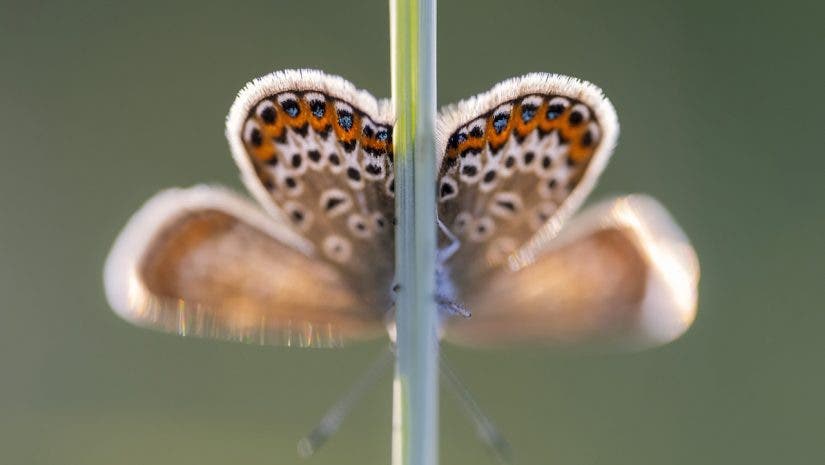Fall brings more than cool weather and colorful leaves to North America. It’s also the season for the mesmerizing Monarch Butterfly Migration, with millions of copper-hued monarch butterflies traveling 3,000 miles north to south before reaching their final stop: central Mexico. This dazzling migratory event — the only kind like it among butterflies — is visible in migration pathways across the country from September through November. (See here for Monarch Watch’s migration map.)
To help you make the most of this fall’s butterfly migration, we talked with renowned U.K. wildlife and macro photographer Ross Hoddinott, who’s been photographing insects since age ten. In fact, Hoddinott wrote a book on macro photography. You can find it via Ammonite Press at Digital Macro & Close-Up Photography.
Here are his top tips to help you nail those butterfly migration photographs this year.

Butterfly Migration Photography Tips
Don’t rush
As any wildlife photographer can attest, capturing the perfect shot takes time — and the same goes for butterflies.
“Patience is key,” Hoddinott said. “I’d also say a good understanding of the subject and its preferred habitat and food plants is beneficial.”
Hoddinott recommends early morning or late evening for photo timing. That’s when butterflies tend to be less active and therefore, easier to photograph.
If you are able to locate insects roosting (at rest), it can be possible to set up a tripod and have more control over the picture-taking process, background choice, focusing, framing, and lighting.
Use a macro lens
If money allows, Hoddinott recommends a macro lens.
“Although close-up filters and auto extension tubes offer a great cut-price introduction to shooting frame-filling shots of insects,” he said, noting that’s how he started out as a child.
Hoddinott uses the Nikkor 200mm Micro lens that, while “old” in the world of gear, is “optically superb.”
“Its telephoto length provides a good working distance that helps minimize subject disturbance,” he said.
He recommends using it on a tripod for stability. The Nikkor Z MC 105mm Micro is his go-to for hand-held shooting.
Don’t overlook background
While it’s easy to focus on the subject at hand — butterflies — Hoddinott mentioned that the backdrop is equally important to make those bold colors pop.
“I work hard to create clean, diffused backgrounds that my subject will stand out against,” he said. “My backgrounds are always natural and created either through putting distance between my subject and its background, or a shallow depth of field.”
Clean, clutter-free backgrounds that are void of distractions are a must-have. To really capitalize on those enchanting colors, he recommends shooting either during the morning or evening when the soft light brings out the natural richness in each color.
Be still
Just as important as being patient? Staying still.
“Insects react to sudden movements, so it’s important to move into position slowly, but efficiently, avoiding any rapid or jerky movements,” he said.
In addition to keeping tabs on your own body, Hoddinott recommended watching your shadow as well: “Be careful not to cast your shadow across your subject either, as this may alarm it and it will fly away.”
Enjoy the challenge
The first couple attempts at photographing the monarch butterfly migration may be trying. You can’t control what the butterflies do and how they move. Therefore, you have to be patient and work with what’s at hand.
But fear not, because it will get better. Hoddinott mentioned it’s the challenge of proper composition and patience that keeps him coming back for more.
“Being able to reveal and highlight exquisite miniature detail, shape, color, and design that’s often unseen or overlooked by others is rewarding,” he said. “Butterflies are such beautiful animals, they’re so varied and interesting. I enjoy getting close to these creatures and enjoy the challenge of trying to photograph them in a creative or unconventional way.”

How to see the fall monarch butterfly migration
To determine when it’s time to catch the monarch butterflies in your area, follow Journey North’s butterfly-migration map. This helpful map aggregates user-reported sightings and provides one of the best snapshots of the migration progress (similar to a fall-foliage leaf-color report). You can also participate in the migration tracking yourself by reporting a monarch-butterfly sighting near you!

Ross Hoddinott’s photography kit
Hoddinott, a longtime Nikon photographer and Nikon UK alumni, shared his go-to gear for insect photography. These are the items he swears by:
- Nikon D850 DSLR
- Nikon Z7II with Nikkor 200mm and 105mm micro lenses
- Gitzo systematic tripod
- Geared tripod head
- Small reflectors, diffusers, and LED devices for manipulating light
To learn more about insect photography, don’t miss the Photographing Giant Insects show with Tamara Lackey on Adorama TV.






